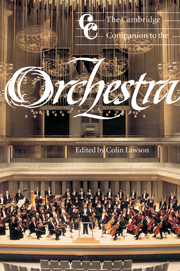Book contents
- Frontmatter
- 1 The history of the orchestra
- 2 The development of musical instruments: national trends and musical implications
- 3 The orchestral repertory
- 4 From notation to sound
- 5 The art of orchestration
- 6 The history of direction and conducting
- 7 International case studies
- 8 The revival of historical instruments
- 9 Recording the orchestra
- 10 Training the orchestral musician
- 11 The life of an orchestral musician
- 12 Historical recordings of orchestras
- 13 The orchestral composer
- 14 Educational programmes
- 15 The future of the orchestra
- Notes
- Appendices
12 - Historical recordings of orchestras
Published online by Cambridge University Press: 28 September 2011
- Frontmatter
- 1 The history of the orchestra
- 2 The development of musical instruments: national trends and musical implications
- 3 The orchestral repertory
- 4 From notation to sound
- 5 The art of orchestration
- 6 The history of direction and conducting
- 7 International case studies
- 8 The revival of historical instruments
- 9 Recording the orchestra
- 10 Training the orchestral musician
- 11 The life of an orchestral musician
- 12 Historical recordings of orchestras
- 13 The orchestral composer
- 14 Educational programmes
- 15 The future of the orchestra
- Notes
- Appendices
Summary
Introduction
As late as the 1970s historical recordings of orchestral music were virtually ignored. A few enthusiasts stored collections of 78 rpm records in their attics, and spoke reverently of the pre-war Vienna Philharmonic Orchestra, as a motoring enthusiast would talk of the red RR on an early Rolls-Royce. But almost no old orchestral recordings were available in transfers to LP, apart from a few concerto recordings valued almost exclusively for their soloists. The sixteen-year-old Yehudi Menuhin's 1932 recording of Elgar's Violin Concerto, conducted by the composer, was rightly regarded as extraordinary. But its value was taken to lie exclusively in the beautiful playing of the miraculous teenager. The fact that it was conducted by Elgar was of little more than sentimental interest. And as for the orchestral playing, the predominant view was that it was something of a mess, and demonstrated how much orchestral standards in Britain had improved since the 1930s.
By the early twenty-first century, reactions to orchestral playing of that period have become more complex and less dismissive. We have become accustomed to the sounds of early twentieth-century orchestras through the thousands of reissues now available on CD. Only thirty years ago the rare speaker who wanted to play a pre-war orchestral recording on BBC Radio 3 would have to find the original 78 rpm records in the BBC library or in a private collection. Now hardly a day goes by without a historical orchestral recording being played on Radio 3, and it is almost always taken from a CD reissue. Music shops are full of them, and they have become so widely accepted that in many shops they are not restricted to a separate ‘historical’ section, but mixed up with the latest digital recordings, often at the same price. The past is ever-present.
- Type
- Chapter
- Information
- The Cambridge Companion to the Orchestra , pp. 203 - 217Publisher: Cambridge University PressPrint publication year: 2003



